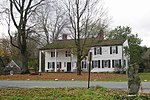David Mathews House
1800 establishments in New York (state)1800 establishments in VermontBuildings and structures in Shaftsbury, VermontFederal architecture in New York (state)Federal architecture in Vermont ... and 7 more
Hoosick Falls, New YorkHouses completed in 1800Houses in Bennington County, VermontHouses in Rensselaer County, New YorkHouses on the National Register of Historic Places in New York (state)Houses on the National Register of Historic Places in VermontNational Register of Historic Places in Bennington County, Vermont

The David Mathews House, also known as the State Line House, is a historic house straddling the state line on New York State Route 67 and Vermont Route 67 in Hoosick, New York and Shaftsbury, Vermont. Built about 1800, it is an imposing brick example of Federal architecture. The building is the subject of a number of tales, some of dubious authenticity. It was listed on the National Register of Historic Places in 1979.
Excerpt from the Wikipedia article David Mathews House (License: CC BY-SA 3.0, Authors, Images).David Mathews House
NY 67,
Geographical coordinates (GPS) Address External links Nearby Places Show on map
Geographical coordinates (GPS)
| Latitude | Longitude |
|---|---|
| N 42.940833333333 ° | E -73.274444444444 ° |
Address
David Mathews House (State Line House)
NY 67 5565
12090
New York, United States
Open on Google Maps











